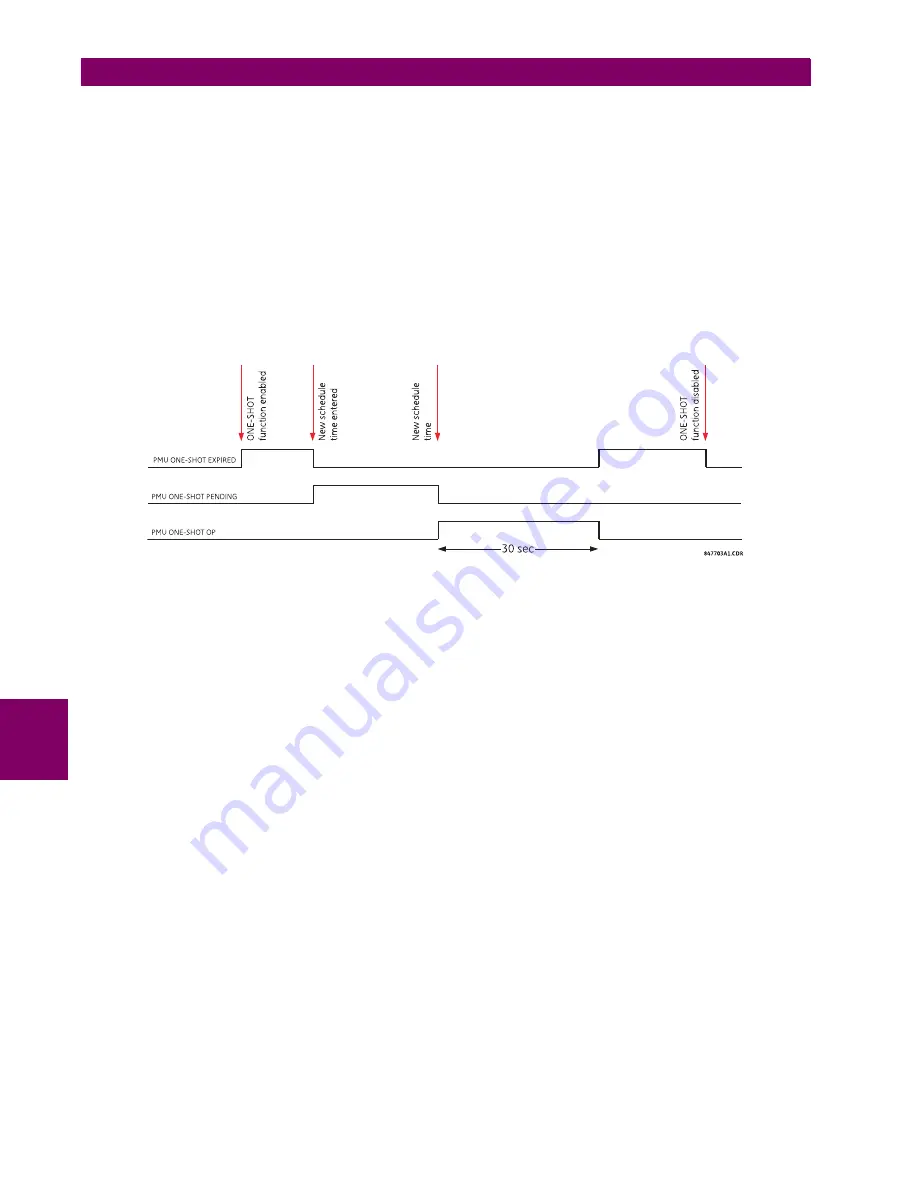
7-4
L90 Line Current Differential System
GE Multilin
7.1 COMMANDS
7 COMMANDS AND TARGETS
7
set time and pre-set sequence number (via the faceplate display, supported communication protocols such as Modbus or
DNP, and the EnerVista UR Setup software).
When freezing the actual values the function also asserts a
PMU ONE-SHOT OP
FlexLogic operand. This operand may be
configured to drive an output contact and trigger an external measuring device such as a digital scope with the intent to ver-
ify the accuracy of the PMU under test.
With reference to the figure below, the PMU one-shot function (when enabled) controls three FlexLogic operands:
•
The
PMU ONE-SHOT EXPIRED
operand indicates that the one-shot operation has been executed, and the present time
is at least 30 seconds past the scheduled one-shot time.
•
The
PMU ONE-SHOT PENDING
operand indicates that the one-shot operation is pending; that is, the present time is
before the scheduled one-shot time.
•
The
PMU ONE-SHOT OP
operand indicates the one-shot operation and remains asserted for 30 seconds afterwards.
When the function is disabled, all three operands are de-asserted. The one-shot function applies to all logical PMUs of a
given L90 relay.
Figure 7–1: PMU ONE-SHOT FLEXLOGIC OPERANDS
TESTING ACCURACY OF THE PMU:
The one-shot feature can be used to test accuracy of the synchrophasor measurement. GPS-synchronized tests sets per-
form a similar function to PMUs: instead of measuring the phasor from physical signals with respect to the externally pro-
vided time reference, they produce the physical signals with respect to the externally provided time reference, given the
desired phasor values. Therefore the GPS-synchronized test sets cannot be automatically assumed more accurate then
the PMUs under test. This calls for a method to verify both the measuring device (PMU) and the source of signal (test set).
With reference to the figure below, the one-shot feature could be configured to trigger a high-accuracy scope to capture
both the time reference signal (rising edge of the 1 pps signal of the IRIG-B time reference), and the measured waveform.
The high-accuracy high-sampling rate record of the two signals captured by the scope can be processed using digital tools
to verify the magnitude and phase angle with respect to the time reference signal. As both the time reference and the mea-
sured signals are raw inputs to the PMU under test, their independently captured record, processed using third-party soft-
ware, is a good reference point for accuracy calculations. Such a record proves useful when discussing the test results, and
should be retained as a part of the testing documentation.
Note that the PMU under such test does not have to be connected to a real GPS receiver as the accuracy is measured with
respect to the timing reference provided to the PMU and not to the absolute UTC time. Therefore a simple IRIG-B genera-
tor could be used instead. Also, the test set does not have to support GPS synchronization. Any stable signal source can
Summary of Contents for UR Series L90
Page 652: ...A 16 L90 Line Current Differential System GE Multilin A 1 PARAMETER LISTS APPENDIX A A ...
Page 772: ...B 120 L90 Line Current Differential System GE Multilin B 4 MEMORY MAPPING APPENDIX B B ...
Page 802: ...C 30 L90 Line Current Differential System GE Multilin C 7 LOGICAL NODES APPENDIX C C ...
Page 812: ...D 10 L90 Line Current Differential System GE Multilin D 1 IEC 60870 5 104 APPENDIX D D ...
Page 824: ...E 12 L90 Line Current Differential System GE Multilin E 2 DNP POINT LISTS APPENDIX E E ...
Page 834: ...F 10 L90 Line Current Differential System GE Multilin F 3 WARRANTY APPENDIX F F ...
Page 846: ...xii L90 Line Current Differential System GE Multilin INDEX ...















































